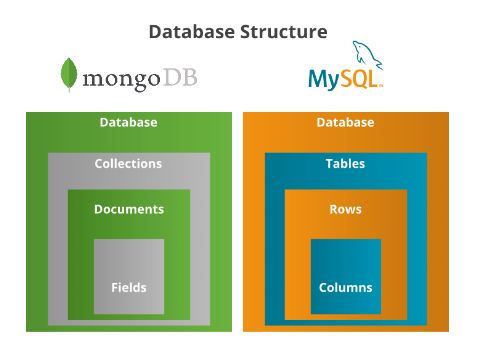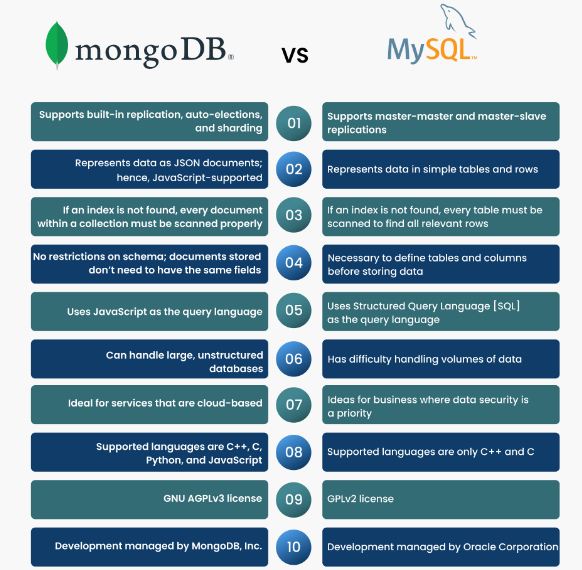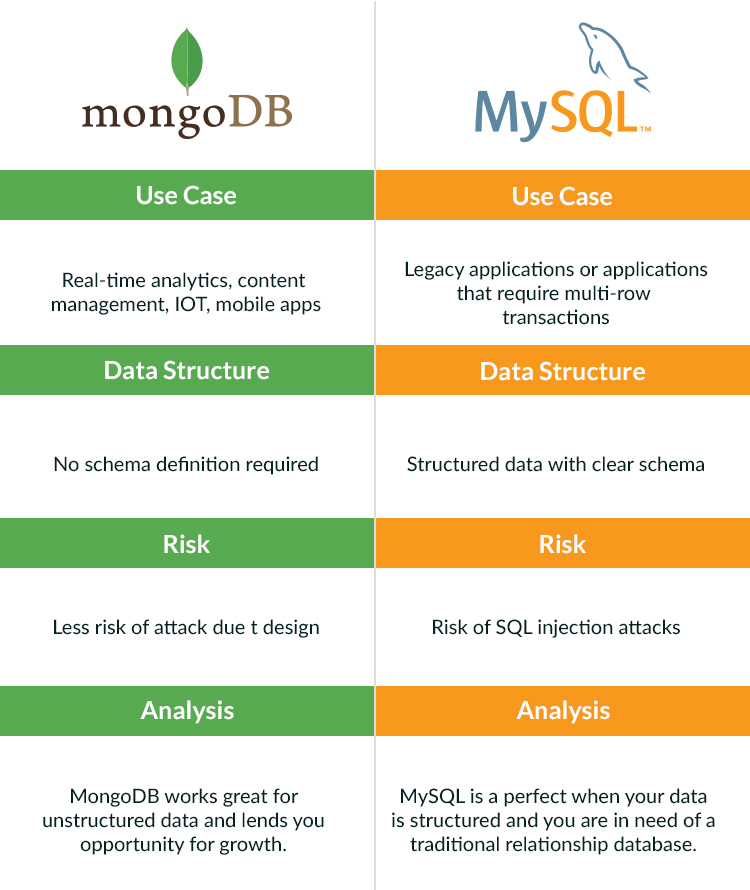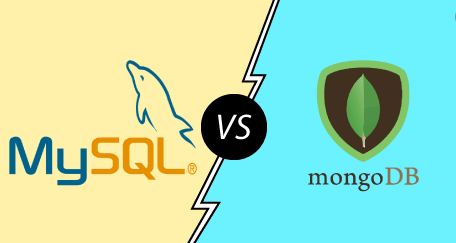This article on MongoDB versus MySQL is an interesting take on the the major points of both these database handling/management systems (DBMS). But before, we proceed further with the topic. Lets get ourselves a brief overview of both MongoDB and MySQL DBMS(s).
What is MongoDB?
This DBMS is a multi-cross platform open-source, NoSQL DBMS. It follows a document oriented approach. Thereby, it utilizes JSON documents known as BSON files in MongoDB for document storing. Thus, it is also compatible with JSON data handling. It is also schemaless, i.e. it doesn’t follow any defined structure to create documents and hence, is dynamic.
It first came onto the scene in 2007 being in development by the MongoDB Inc. There have been many updates since. With the latest version being 4.4.3 as of the end of 2020.

Now, What is MySQL?
This is a RDBMS which is the relational form of DBMS. It is so called because it stores data in the form of tables which has rows and columns. Also, it is an open-source, structured Query language.
It also stores data in the form of tables containing rows and columns, correlating the data by the use of various Join Operations.
It is developed by Oracle. And, it has also gone with various updates and the latest release is version 8.0 as of current.
MongoDB versus MySQL : Comparative Lens
Now, that we know about MongoDB and MySQL. Lets discuss the various major points to compare these two Database Management Systems. So, that we can increase our knowledge and also facilitate our use of these systems based on our requirements.

Flexibility of Schema
We already know that MongoDB is schema-less. Hence, there isn’t much restriction on storing the data except that it be in the supported data structures.
Also, there aren’t any joins or transactions. Hence, one may have to frequently optimize the schema to see how the information is getting accessed. MongoDB creates schema-less documents which may store any information one would want. Though it may be a cause of problems due to data consistency.
Now while storing anything in MySQL, one would do well to obviously define tables and columns. With each row in the table having an equivalent column.
MySQL creates a strict schema-template and hence it’s sure to make mistakes.
The Querying Language
MongoDB uses an unstructured command language. Thus, one has to specify a document with relevant properties to match while querying JSON documents.
While, MySQL uses the structured command language SQL to converse with the database. Despite its simplicity, it’s indeed a really powerful language which consists mainly of four parts: Data Definition Language (DDL), Data Manipulation Language (DML), Data Query Language(DQL) and Transaction Control Language(TCL).
Relationships in MongoDB and MySQL
MongoDB doesn’t support JOIN operations. On the contrary, it supports multi-dimensional data types like arrays and even other documents. It also supports the concept of nested or embedded documents.
On the other hand, MySQL supports JOIN operation. It is due to these JOIN operations only that MySQL is referred to as a Relational Database. JOIN allows the user to link data from two or more tables while running a single query with the assistance of the “SELECT” command.
Speed and Performance
Developers say that MySQL is a touch slower in comparison to MongoDB when it involves handling large databases. MySQL is unable to deal with very large and unstructured amounts of information or data.
MongoDB performs well optimized query operations which are more sensitive to workload and hence faster. It handles unstructured data which is also a major plus point over MySQL.
In a recent research involving over 1,000,000 records of Amazon it was seen that MongoDB is a lot faster and well-suited to MySQL to handle these data.
Anyways, the choice of the DBMS is dictate by your requirements and the data you have to deal with.
Security
MongoDB uses a role-based access control with a versatile set of privileges. Its security measures include authentication, auditing, and authorization. Moreover, it’s also possible to use Transport Layer Security (TLS) and Secure Sockets Layer (SSL) for encryption purposes. This ensures that it’s only accessible and readable by the intended client.
On the contrary, MySQL uses a privilege-based security model. Thus, it authenticates a user and facilitates it with user privileges on a specific database like “CREATE“, “SELECT“, “INSERT“, “UPDATE”, and so on. But it fails to elucidate why a given user is denied specific access. On the transport layer, it uses encrypted connections using the SSL among servers and clients.
Want to know why MongoDB is used? Then, read here……
Sharding
When the data is disparate across several machines which support deploying of large datasets and huge throughput operations it comes to be known as Sharding. The disk drives and CPU can get stretch due to the higher query rates and large disruptive datasets which stresses the RAM to put subsequent pressure on these devices.
But, there is a solution to this problem in the form of Vertical and Horizontal Scaling. In vertical scaling, the overall capacity of a server is increase by enhancing these devices, i.e. the RAM, the disk drives and the CPU, etc. While, in Horizontal Scaling, the dataset gets divided into multiple subsets. And, each machine is require to handle a lesser amount of the workload hence, a lower cost comparatively.
MongoDB’s sharding has the capacity to empower users with automated failure and redundancy of data.
And, in MySQL, there are two ways of Sharding like MySQL Cluster(built-in automated sharding functionality) and the MySQL Fabric(official framework).

Disadvantages : MongoDB versus MySQL
Now, that we have seen the comparisons on the basis of several major points. Lets look into the major disadvantages of each of these platforms.
Cons of MongoDB
- MongoDB doesn’t support JOIN operations.
- It also doesn’t follow the ACID properties strictly. Thereby, handling complex transactions generally become complicate.
- Also, there is a challenge in using the business logic’s at the database level as there is not provision for stored procedure and/or functions in MongoDB.
- The information redundancy there leads to higher memory space usage as it stores the key for every key-value pair.
- The documents size is restrictive to 16MB only.
Cons of MySQL
- It isn’t efficient when it involves large databases.
- Also, it has performance issues when scaling databases.
- As, MySQL databases have a schema, they’re susceptible to SQL injection attacks.
- They have a pre-defined well aligned structure.
- It is cumbersome to work with rows and columns, i.e. tables.
SUMMING UP
We have seen the multi-featured comparison of MongoDB and MySQL DBMS. We have seen how in the end, it all depends on the type of data we are working on and the requirement that we possess. So, it is a basic choice that we have depending on our work scheme. That is if we are too concerned with speed and performance then we shall opt for MongoDB. Whereas, if we need to work with transactions and structured data then we need to go with MySQL.
